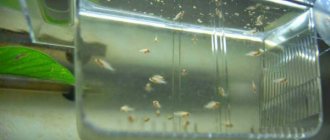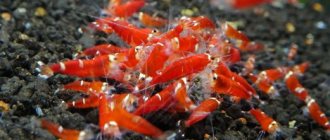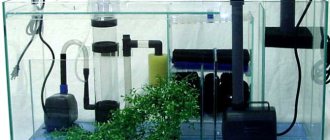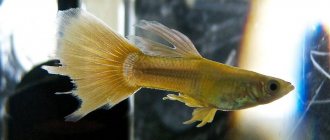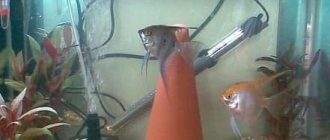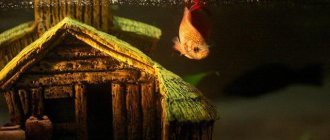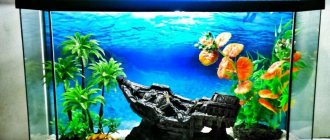Guppy
Author of the article: Olya Stvolova
Baby guppies are unique fish that are born from their mother’s womb, fully formed and ready for independent life! Therefore, it is not difficult to care for them, and it is always interesting to watch. Right before your eyes, a beautiful adult fish grows from a 3-5 mm fry. Due to the fact that guppies are guilty of cannibalism, the mother should be separated from the offspring immediately after birth.
14:43
GUPPY GIVING GIVING!Spawning live-bearing fish
Mother guppies eat their fry at the first opportunity, often without even waiting for the end of labor, provided that the baby itself swims to a critically close distance. After all, giving birth and hunting at the same time is quite problematic!
Guppy fry in a community aquarium
The survival rate of fry of any breed in a community aquarium is usually very low. Many of them die in the first hours after birth. What does this mean:
- A large number of natural enemies, including adult representatives of the same species, incl. parents;
- A small number of plants and small shelters;
- Lack of food because adult fish often eat everything clean;
- High population density in the aquarium;
- Aquarium equipment – filters and compressors. These life-saving devices often suck in, kill and/or maim small fish;
- Inadequate water quality. The immunity of fry is much weaker than that of their adult relatives, so what is normal for adult fish can cause illness and death for babies.
Thus, if you are pursuing the goal of preserving the offspring, but were unable to place the female in time, it is better to try to catch the fry from the general aquarium, rather than letting their survival take its course. If you don’t have such a goal , you can see the process of natural selection in action with your own eyes! The smartest and fastest will survive, but you shouldn’t expect outstanding external data from the survivors!
Small fish need as many shelters as possible, incl. plants.
With uncontrolled reproduction in a community aquarium, a common occurrence is degeneration of the breed. The appearance of the fish deteriorates generation after generation. Breed characteristics disappear. Therefore, we recommend buying new producers and fresh blood from time to time.
If you want to try to save the fry in a community aquarium, then you will need to replace the water twice a week, in a volume of at least 1/3 of the total volume. Carefully monitor the functioning of the systems, because during growing up all external factors are of great importance: lighting, temperature, filtration and aeration. In addition, the fish will have to be fed 3 times a day, with slightly larger portions of the fine fraction. If possible, you should increase the number of natural shelters - small-leaved plants, in which the fry can easily get lost.
Varieties
You can make a depositor with your own hands. But before you get started, it is important to find out what types of devices exist and which one is more suitable in a particular case:
- Reticulate
This type of depositor is a device with soft walls made of wire stretched over a frame. Such aquariums are located in a common aquarium. They are attached to the walls using suction cups or fixed at the edge with special hooks. The advantage is that there is no need to create a separate environment. Disadvantages - accumulation of debris, risks that adults will be able to get inside the fish tank where the fry are located. - Transparent
The material for production is high-quality plastic with a transparent structure, plexiglass or glass. The device is attached to the walls. You can simply place it on the surface of the water. The basic rule of use is that the wall of the fish tank must exceed the water level of the aquarium. Such devices cost an order of magnitude higher than mesh ones. Plastic devices are considered the most comfortable for fish, but the water there quickly becomes dirty, so you need to carefully monitor it. - Combined
Combines the two previous designs. The wall is made of mesh, the others are made of plexiglass or plastic. Advantages - the fish are in their familiar ecosystem. Disadvantage: food residues may remain on the mesh, which will lead to rapid contamination of the water.
Selection rules. Separators have different pricing policies. But you need to understand that the product must be made of high-quality materials, especially plastic. To be sure of reliability and safety, it is recommended to make a depositor yourself.
For fry, it is recommended to use a device with solid walls made of plastic or glass.
They are safer and more reliable than depositors in which the walls are made of mesh. In addition, plastic devices are easier to keep clean and easier to replace water.
Caring for guppy fry
Caring for fry is simple, you just need to remember simple points:
- Well equipped aquarium;
- Quality food;
- Maintain the water in the required parameters and do not change them suddenly.
Let's take a closer look at each of them.
Aquarium equipment
The minimum package of equipment for raising guppy fry is a filter and compressor, a lamp and a heater, a thermometer. It is more convenient to use 2-in-1 devices. The filter must be turned on to minimum settings and a fine sponge must be used. An incandescent lamp, with constant supervision and monitoring of the temperature, will replace the heater. However, such lighting can provoke the growth of algae.
Water parameters
The water parameters for fry and adults do not differ critically, but they are worth comparing.
The fry require the following environmental parameters:
| Volume of water (in liters per 1 fry) | Temperature (°C) | Acidity (pH) | Hardness (mol/m³) |
| 0,5 | 26 — 28 | 7 | 10 -20 |
Adult guppies prefer:
| Volume of water per individual | Temperature (°C) | Acidity (pH) | Hardness (mol/m³) |
| 2.5 liters | 22-26 | 6,5-7,8 | 10-25 |
For favorable survival of babies in the same aquarium with adult fish, you need to choose average indicators that are suitable for both the former and the latter.
Fry from the hatchery
Baby guppies born in a separate container, upon reaching 1.5 centimeters in height, can be moved to an adult aquarium. Now they are large fish and nothing threatens them (or almost nothing). As for the age required for relocation, each fish, like any other child, develops at its own pace. Therefore, some will move to an adult jar at the age of 1 month, while others may stay in kindergarten until 3! Some of the brood become colored, reaching 1 cm, while others still have an unattractive, wild appearance for a long time.
Before moving:
- Provide as many hiding places as possible in an adult aquarium;
- Reduce the speed of the filter, it can still cause damage to small fish, although it is no longer fatal.
- Accustom the fry to water from an adult aquarium. To do this, add water from an adult aquarium to their aquarium for 2-3 days and equalize the temperature in the two containers, if this has not been done before.
For guppy fry, a fish tank attached to an adult aquarium is perfect. With its help you can easily solve the problem of moving.
Why do you need a depositor?
If your beloved pets in an artificial reservoir have begun to reproduce, it means that conditions suitable for breeding have been created for them, and the condition of the reservoir is in order. However, the main goal of the owner of the reservoir is to create a safe place for future offspring where the fish will feel safe. This is a homemade fish tank for fry, or purchased at a pet store - it will provide the fry with protection and safety from large and large fish. If the fry are not fenced off in time from the neighborhood with other species, then the tiny inhabitants will be eaten for dinner or breakfast.
A fish tank for an aquarium can be placed directly into the tank itself - then you can be sure that the environment is favorable for development, and the walls of the tank, separating the fish from older phenotypes, will provide protection. Before spawning, future parents - adult fish - are placed in a separate small tank; after successful reproduction, the couple is resettled into a common reservoir, and the tank accepts new residents - tiny fry. Before you start building a fish tank with your own hands, you should learn better about the types of this accessory.
Feeding
During the first time after birth, the so-called newborn period, the fry still feed on the contents of the yolk sac, but this is only enough for a couple of hours, which means you need to start feeding the guppy fry from the first hours after birth.
During this period and until the fry reach the age of 7 days, their diet primarily consists of live dust, microworms and boiled chicken egg yolk crushed into dust.
You can purchase live dust at a pet store or from breeders, or dilute it yourself.
Feeding during this period is carried out 5-7 times a day at approximately equal intervals. It is very important that the daylight hours of the guppy fry at this time should not be less than 20 hours!
Feeding fry that have reached the age of one week is greatly simplified.
Fry from 7 to 50 days are already less whimsical in food and happily absorb any food that fits into their small mouths. Dry food mixtures, which can be easily purchased at any pet store, are well suited for teenagers. However, on high-quality live food, babies grow noticeably faster and quickly acquire their characteristic bright colors. During this period, it is good to give the fry: Artemia nauplii, crushed tubifex and bloodworms. It is now enough to feed them 3 times a day, and gradually reduce daylight hours to the standard 10 - 12 hours.
Upon reaching 60 days of age, guppy fry are considered conditionally adults and their feeding regime should coincide with the feeding of fish in a general aquarium.
Correct installation of the depositor
It is recommended to mount the device in the aquarium near the aerator.
If air bubbles do not reach it, the water will begin to stagnate and become contaminated faster.
Care of the septic tank. It is important to promptly clean the container from food debris and organic traces. It is recommended to especially carefully monitor the depositor made of mesh, since food debris is constantly clogged into it.
A fish tank is a device that every aquarist should have. This can be a free-floating container or mounted on the walls of the aquarium. A fish tank is used for a pair of fish during spawning, and later to protect the fry.
The advantage of this design is that the fish remain in their familiar environment, but at the same time, they are provided with reliable protection from unfriendly neighbors. You can prepare a depositor yourself from a plastic bottle, or buy a ready-made one at a pet store. Preference is given to plastic devices with hard walls.
How do guppies grow?
We have already mentioned the uneven growth of offspring from the same litter. However, the average growth parameters are:
- 1 day 2 – 5 mm.,
- 1 week 7 – 10 mm.,
- 1 month 10 – 20 mm.
Baby guppies grow quickly, but not evenly!
Guppies reach sexual maturity at the age of 2-4 months. And the first signs of sexual differences, the anal spot of females, become noticeable at 15 days of age . If you intend to select females and males, you need to resettle them immediately after the first sexual differences are discovered. After all, early-maturing fish can start mating without waiting for 2 months of age, this happens and is not considered uncommon!
Do not keep young males and females in the same jar, this will lead to uncontrolled inbreeding and degeneration!
Potential Difficulties
Difficulties await aquarium owners everywhere, even such a simple process as breeding viviparous guppies and raising their young can result in unexpected troubles...
- Beautiful and diverse selective forms are often unable to produce offspring, produce few fry, or their offspring do not copy the appearance of their parents.
- Poor quality care leads to diseases, sticky tail, spinal deformation, loss of aesthetic appearance and other troubles.
- Too many fish in an aquarium can also cause disease. Therefore, think in advance about how many fry you will keep for yourself, and for the rest you need to decide the fate in advance.
14:04
Guppy Treatment
What to do with guppy fry
One of the most important questions that sooner or later faces a guppy breeder is what to do with the fry? There are several options for solving this:
- Beautiful and healthy fry will replenish the colony of your guppies in a community aquarium.
- Guppy fry are selected based on their external characteristics for further breeding and selection. In this case, females and males are kept separately.
- No matter how cruel it may sound, this is how nature created them. Guppies and other aquarium inhabitants will happily feast on the fry, just like any other live food. Only in the freshness and quality of newborn fish can you be 100% sure!
- Individuals that have reached a size of 1.5 - 2 cm can be handed over to a pet store or sold at a bird market or specialized sites (Yula, Avito, etc.) Be prepared for the fact that outbred nobles will not be sold for more than 10 - 15 rubles. But the cost of beautiful purebred males can reach several hundred.
Good luck with breeding and growing, Fish in a Jar!
What is a depository
Spawning of aquarium fish is possible if favorable conditions are created that are as close as possible to their natural habitat. The behavior of the fish shows when they are ready to reproduce. Mating games are the best indicator of this and the best time to prepare the breeder.
Purpose of the device:
- Protection from "parents" . Representatives of some aquarium fish do not have parental instinct. They can eat their eggs and actively hunt growing fry.
- Protection from other inhabitants . In a community aquarium containing several different species, more aggressive neighbors may enjoy preying on the fry.
- Keeping the weak alive . The hatchery is used not only for fry and spawning. There are situations when fish, obeying the laws of hierarchy and possessing aggressive character traits, can attack their fellow tribesmen. Weak and wounded individuals may be excluded from the flock. To restore their health and protect them, a depositor is used.
- Preparing a pair for spawning . In a multi-species aquarium, there may be some difficulties with the mating season. So that no one disturbs the fish, and they can calmly prepare for reproduction, they are isolated for several days.
A depositor is not just a separate reservoir of water. This is a method of isolating fish in a common aquarium in their familiar ecosystem. Only there is no contact with other individuals.
